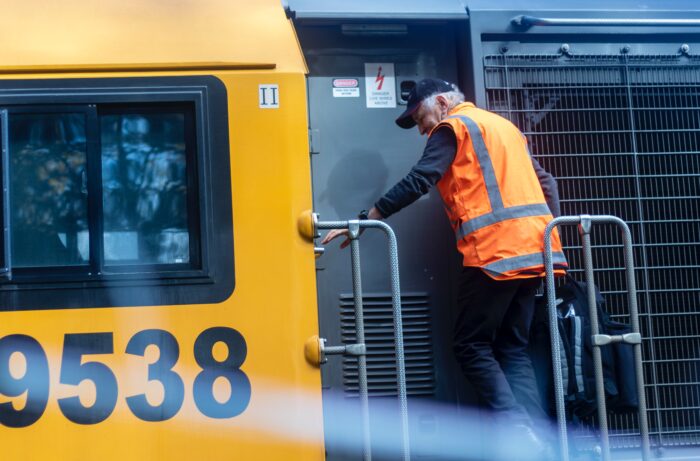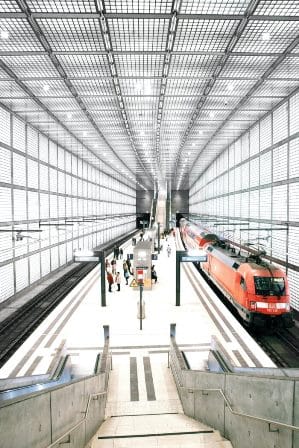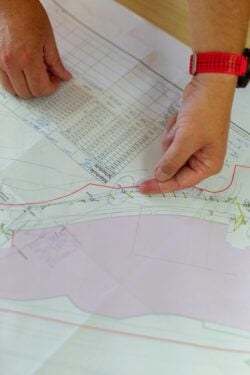Trains are good. Rail is considered an energy-efficient and the least carbon-intensive transport used in the world. And railway engineering is here to stay, for decades.
Passenger and freight transport by extension is sustainable and does allow for better use of resources as well as efficient use of fuel.
Even better, electric trains are rapidly overtaking diesel or fuel locomotives to make it more viable than ever to lay new tracks.
The question is, where does this leave engineers that specialize in railway engineering? We will cover it here.

The ‘new’ shift toward the rail
The International Energy Agency (IEA) has been producing annual reports on the future of rail for years, and the 2021 data shows that there is a need to look at railways again as an essential part of transport and infrastructure.
According to the report, 8% of global travel is by train.
Globally 9% of freight is also rail activity.
While this sounds low compared to other travel or freight solutions, the growing interest in freight will be due to its sustainability.
Currently, only 3% of the energy used globally is from railways.
These figures are noteworthy – so much so that International Non-Governmental Organizations like Greenpeace have taken note and advocated for railways more vehemently.
One of the key focus areas under Greenpeace research is how effective passenger railway lines will be in Europe to ensure less damage to the environment.
Short-haul flights or under particular scrutiny from the organization in their 2021 report Get on Track: Train Alternatives to short-haul flights in Europe.
Greenpeace’s main concern is that flights under 1500km are not only elitist (with only 1% of the population with true access to these flights) but these flights account for a quarter of the European Union’s aviation emissions.
The CO2 impact and the non-CO2 impact of air transport include pollutants such as oxides of nitrogen (NOx), soot particles, and water vapor and this is twice as bad for the environment as regular CO2 emissions.
These facts when compared to trains are severe. Greenpeace estimates that 62% of Europeans support the ban on short-haul flights and the improvement of railway alternatives.
One of the reasons for this level of support is the fact that short-haul flights can usually be undertaken in train trips that equal less than six hours.
Rails are more established, and as a result, there’s a lot more ease of access, travel is more convenient and importantly it strengthens the railway industry to improve further, which will lead to the reduction of tickets to travel by train, new and improved routes and ultimately better and more energy-efficient and environmentally friendly trains.

Looking at Europe, Greenpeace made the following estimates:
- Around 34 % of 150 busy flight routes can be made by train in six hours or less.
- 29 % of Europe’s busiest short-haul flight routes can also be made by train for under six hours.
- 27% of the 150 busiest flights on the continent have train alternatives that run during the night.
- 81 million Europeans have direct access to trains that will get them to a European destination in under 6 hours.
The International Energy Agency is also clear on the virtues of rail when compared to other travel options.
For the agency the low CO2 impact of rail coupled with the fact that rail travel has been consistent, there’s reason to believe rail can be the answer to alternatives to car and air travel. But rail is still overly concentrated.
China, Europe, India, Japan, and Russia register 90% of global passenger rail activity. Expanding it globally is vital for the world to reach net-zero goals.
These goals can be reached if only 13% of total transport activity is through rail.
To get their targeted and more ambitious government policies, advancements in rail and the digitization of railway systems with a shift toward rail are necessary.
Key focus areas in railway engineering
1. Railway Infrastructure
For engineers specializing in railway infrastructure, the European Commission is a good anchor point to look at future development.
The EC is developing a Single European Transport Area and has promoted a shift from road to railway.
Previous research emphasized the application of technology in solving problems within the industry.
Currently, the EC is compiling a special issue that looks at practical knowledge that has been developed with corporate knowledge, science and technology that are still deficient in innovating the railway industry fundamentally.
Some infrastructure solutions include the applicability of low-vibration tracks in heavy-haul railways.
A Portuguese–Brazilian team presented an efficient methodology for calibrating a numerical model of a freight train locomotive with an Sgnss-type wagon based on experimental modal parameters, namely natural frequencies and mode shapes.
Dynamic tests were performed for two distinct static-loading configurations, tare weight and current operational overload, under demanding test conditions, particularly during unloading of the train and without disturbing its tight operational schedule.
Another study regarding the applicability of heavy-haul railway tunnels

This paper researched the dynamic effects of heavy-haul railway wheels and rails and provided a technical reference for the structural design of heavy-haul railway track structures.
Based on vehicle-track coupling dynamics, the stability of the upper heavy-haul train, the track deformation tendency, and the dynamic response sensitivity of the vehicle-track system were analyzed.

2. Rolling stock
Engineers are still faced with perfecting and improving railway rolling stock.
The calculation of load shift, elongation and forces in elastic elements of fasteners are always under the microscope and considering plans to expand railways globally effective rolling stock management is important.
Many current articles and studies in the field use the basic law of dynamics in relative motion for the non-ideal connection from theoretical mechanics.
Calculations can vary but most are focused on load fastening elements, determining the load shifts along with the car, elongation, and forces in the flexible fastening elements of rolling stock.
Often these calculations reveal the value of the coefficient of longitudinal dynamics of the car and its corresponding with the yard the stock is from.
Other focus areas include weight reduction and also new design principles.
3. Railway Operation
Money is a leading driver in how railway operations take place, and it’s worthwhile for engineers to be aware of a full spectrum of the economical background before going into railway engineering.
One paper Investigation of An Operation and Maintenance Framework in the Railway Industry: A Case Study of the Makassar looked at railway lines in Indonesia and established many worthwhile points engineers can explore wherever they find themselves.
The project ran different simulations on the railway experience, from ticket buying, maintenance and how cash flow is generated and was able to generate figures on various parts of railway operation like maintenance and rolling stock lease.

It also accounted for operation and maintenance and rolling stock investment, operation and maintenance and rolling stock lease and government subsidies, operation and maintenance and asset transfer, operation and maintenance and rolling stock investment and subsidies as well as operation and maintenance plus rolling stock investment and asset transfer.
These figures can generate models of operation that ensures railways are run effectively, cost-effectively and with safety in mind. Alternative aspects of railway operation like sustainability can also be included in future simulations to show the power of the railway.
Where will the engineers come from to handle railways?
These virtues of strengthening railways are reliant on new approaches from engineers. In America, the national railway network has received warm regards from the American Society of Civil Engineers (ASCE).
In its annual report on railways in America, ASCE gives insight into the funding prospects of railways, and why engineers will be able to work with healthy budgets to achieve goals within national railways, but also globally to achieve sustainability goals in terms of freight and transport.

The 2020 report mentions that in America over 40 years USD 700 billion was spent to develop the current network. Broken down in 2018 USD 260,000 was spent per mile to maintain the network and look for new ways to improve the network.
The reduction of bottlenecking, line extensions and information technology solutions are just some of the ways ASCE identified where engineers need to come in and ensure the system stays viable and current.
Track and infrastructure improvements have been able to include the defect detection of vehicles, quicker systems, the life-cycle extension of railways, enhancement of track stability improvement of safety and identification of ground surface problems and improvement cybersecurity systems advancements.
This relies on a healthy workforce, but railway-specific engineering isn’t as en vogue as other engineering disciplines.
One study assessing railway maintenance in Australia insists that Railway organizations saw privatization, downsizing and the loss of engineers in the last 30 years. Engineers migrated to the private sector and railway engineers faced higher workloads because there’s been rapid growth in the railway sector.
Professional development and training for engineers are emerging as a problem because new engineers might not be able to learn from the old guard on-the-job, or access to education is limited.
The 2009 paper Educating the world’s railway engineers looked at the problem.
Civil engineers within the railway industry often maintain and monitor thousands of kilometres of track. This means that these engineers are often not close to cities or universities, and cannot actively take part in post-graduate studies in new railway technologies and norms. They keep the previous knowledge that doesn’t allow them to take part in the circular economy of railway education or its positive environmental change.
Existing knowledge is activated as a foundation for new knowledge according to the paper and the only solution to strengthen railway engineers is for them to be encouraged to use online learning as a new way to create better railways.
online learning as a new way to create better railways.
The paper concludes that web-based learning offers engineers a way to discuss and explore authentic problems within the railway industry, meet their peers and create close ties (even
digitally), become apprenticed into their field of study, enter a community of experts and peers and generally be assisted in the learning process.
Students as they progress through professional-level courses take back new knowledge to their workplace not only increased and highly relevant technical knowledge but also a worldwide network of experts and peers, together with experience in sourcing, sorting and processing complex information about typical challenges faced in the railway industry.
This organic information and skill exchange are important for the railway industry.
How railways are set to grow
Advanced engineering is part of train and rail expansion, and the newly announced Infinity train shows exactly how railways will grow.
At the start of March 2022 UK-based Williams Advanced Engineering (WAE) says it aimed to create hundreds of new jobs through decarbonization initiatives.
WAE announced its intent to create a world-first, zero-emission Infinity Train.
The regenerating battery-electric iron ore train will recharge its battery-electric systems without any additional charging requirements for the return trip. Instead, it self-charges as it speeds down its track.
Fortescue Founder and Chairman, Dr. Andrew Forrest AO, said during the announcement; “The Infinity Train will not only accelerate Fortescue’s race to reach net-zero emissions by 2030 but also lower our operating costs, create maintenance efficiencies and productivity opportunities.”
In a press release released by the company he continued: “The Infinity Train will join Fortescue’s green fleet and will contribute to Fortescue becoming a major player in the growing global market for green industrial transport equipment, providing great value for our shareholders.”
The technology for the train will be developed by Fortescue and WAE.
The Infinity Train could well be the world’s most efficient battery-electric locomotive, bringing down the low emissions from railways even further.

The regeneration of electricity on the downhill loaded sections will remove the need for the installation of renewable energy generation and recharging infrastructure, making it a capital-efficient solution for eliminating diesel and emissions from our rail operations.
It’s a project engineer’s dream.
Hello Mister Robot
One of the fascinating new developments to improve railway efficiency even has to do with cleaning carriages – not just track itself, creating a thriving interdisciplinary between civil engineering and robotics.
In December 2021 a group of scientists from the National Robotarium in Scotland working with Heriot-Watt University and the University of Edinburgh unveiled the design of a new train cleaning robot.
The robot is set to increase cleanliness standards on trains by cleaning difficult-to-reach spots under seats of passenger trains.
According to the press release sent out upon unveiling the National Robotarium spent two years working on the robot.
In the UK, 182 million rail passenger journeys were made on national rail services and travelers want a higher standard of cleanliness on railways. The National Robotarium team used 58,300 studio images of waste in a variety of conditions to help the cleaning robot to identify waste accurately, along with several smaller datasets of actual waste photographed on trains.
In interviews with rail service providers, the team obtained further information regarding operating conditions to guide the design of the robot. The narrow under-seat area, which collects the most waste items, is extremely limited and this makes waste collection challenging. Some spaces were measured at just 28cm tall, with entry points as small as 31cm.
“The demand for skills will change as our businesses adapt and we build on our growing reputation for hi-tech industries, which is why ensuring Scotland has a skilled and productive workforce, both now and in future, is central to our economic ambitions as we adapt to technological change. I’m pleased the Scottish Government is providing £1.4 million to support the Robotarium as we move towards a sustainable and innovative economic recovery.”

Train your brain
EIT offers an Online – Master of Engineering (Civil: Railway Infrastructure) degree that is industry-relevant to allow graduates to have sound knowledge of railways past, present and future.
The postgraduate degree offers professional and technical development for engineers working with track and the infrastructure in the rail corridor.
Comparatively, EIT is one of a handful of institutions offering a specialized degree in the field of railway infrastructure. Many countries have little by way of specialized degrees in the field.
Upon completion of this program, students will gain skills and knowledge in the latest and developing technologies in railway infrastructure – and have the experience to address the needs of the railway industry.
This degree has been developed by railway experts to address the specific needs of the industry. The industry focus of the degree is enhanced through the expectation that students will be employed in the railway industry during all or part of their studies.
The units in this master’s degree were structured with this very purpose in mind.
The degree mixes academic and industry-based learning to provide engineers with more advanced skills and knowledge, much faster than workplace training can do, with specific knowledge focused on railways.
Modules during the two-year degree are hyper-focused on the engineering aspects of railways, and except for an in-depth introduction to railways units covered include Ballast Sleepers and Fasteners, Railway Projects and Systems Engineering, Rail and Related Track Structures, Management of Railway Assets and Engineering Research and Practice.
Units like Track Structure and Capital Works are also of utmost importance. The responsibility of a Railway Civil Engineer extends far beyond understanding and permanently maintaining the track. The unit considers the construction of a new track, and reconstruction of the existing track, which must be managed with insight and competence, particularly concerning interfacing between the project, key stakeholders, and the public.
It requires an appreciation of contracts and their administration, and ability to assess construction and geotechnical risks, and the specification of appropriate construction processes, just to name of few of these considerations.
Another major unit for students during their first year of study is Sustainable Engineering Principles.
This module identifies the link between sustainability and transportation engineering to illustrate that these two areas need to be considered together and not in isolation. To this end, it seeks to incorporate the sustainability theme into the classic engineering principles and
practices around functionality, practicability, cost, materials, designs, and ease of maintenance concerning railways.
Through EIT’s online delivery, railway engineers can study the degree from anywhere in the world. The blend of differing railway contexts, operating standards, practices, and policies experienced by these engineers living in many countries will provide a unique learning opportunity for students as they interact with each other throughout the degree.
The two-year course covers units focused on myriad aspects of railway engineering, culminating in a project thesis.
Students also need to complete 240 hours of Work-Integrated Learning.
EIT’s Master of Engineering programs require students to undertake 240 hours of paid or unpaid professional work-integrated learning. This can incorporate paid or unpaid internships, site visits, contributing to industry projects, and networking activities.
In undertaking an internship, students will interact with employees and become exposed to organizational policy and culture. Students should familiarize themselves with organizational communication procedures, a variety of engineering disciplines, and obtain insight and practical aptitude in projects from the planning phase to completion.
If you already have some work experience in the relevant engineering field, you may apply to have credit granted by completing the associated recognition of prior learning form.
Why Study Railway Engineering?
Engineers within the railway industry are usually highly specialized, and it is reflected in their income.
The latest figures from GoConstruct looked at the railway engineer’s income from many sources and estimates that newly trained rail systems engineers earn between £25,000 – £35,000 (32,790 to 45,906 USD) trained rail systems engineers can earn between £35,000 – £45,000 (45,906 to 59,022 USD) while senior rail systems engineers earn between £45,000 – £70,000 (59,022 to 91,812 USD).
As a civil engineer, however, specializing in railways engineers can look at earning potential between 62,000 and 116,000 USD annually.
Compared to other engineering disciplines this is one of the higher-earning areas, however, your credentials, micro-credentials as well as years of experience also factor into it.
At EIT, we have our own Master of Engineering (Civil: Railway Infrastructure) degree, available to study online from January 2023.
Seven wonders of the train world
The history of rails is deeply entrenched throughout the world, and nearly all countries on earth have a specific history of trains and their introduction to that geographical point.
Looking back, it makes it clear that railway engineering has only evolved throughout time, and it is now also part of humanity’s future as we move into a more sustainable life that includes the modern conveniences of freight and transport.
Here are 7 feats in the world of trains and railways you might not have known:
- Australia has a history of long trains that travel cross-country. The Ghan which started operating in 1929 between the cities of Adelaide and Darwin was on a 2,979km track. Operating on the track at some point in time was a train and carriages measuring about 1.2 km, pulling up to 44 passenger carriages.
- Most of the long-distance passenger trains in India are around 600 meters long, consisting of around 24 coach cars.
- Canada’s maximum allowed length for general cargo freight is 3700 meters. But it has happened that some trains reach 4200m trains that pull double-stack container cars.
- The United States has set its limit on the length of freight trains at 3658m, which was done because of the limits of the air brake technology. However, one special run on the Union Pacific railway consisted of 296 container cars that were pulled by nine locomotives. The total length of that train was impressive 5.5 kilometers (3.4 miles).
- A decade ago China had almost no high-speed rails. Currently, two out of three high-speed lines are in China. In 2020, China revealed the plan to double the rail high-speed network from 36 000 km to 70 000 km over the next 15 years. This will connect all cities with populations greater than 200 000. The country also recently launched its first fully electrified bullet train in Tibet and announced the completion of a hydrogen fuel cell hybrid train.
- India’s Ministry of Railways plans to electrify broad-gauge routes to achieve 100% electrification by 2023. Currently, 45 881 route km have been electrified, despite the Covid-19 pandemic. Indian Railways is one of the 35 members of the International Union of Railways that have formally committed to net zero emissions before 2050.
- In Germany two hydrogen fuel cell passenger trains have been operational since 2018.
References:
Murray, Martin & Rowe, Jillian. (2009). Educating the world’s railway engineers.
Advanced Railway Infrastructures Engineering. Available from: https://www.researchgate.net/publication/358783734_Advanced_Railway_Infrastructures_Engineering [accessed Mar 30 2022].
Investigation of An Operation and Maintenance Framework in the Railway Industry: A Case Study of the Makassar? Available from: https://www.researchgate.net/publication/324831071_Investigation_of_An_Operation_and_Maintenance_Framework_in_the_Railway_Industry_A_Case_Study_of_the_MakassarParepare [accessed Mar 30 2022].


